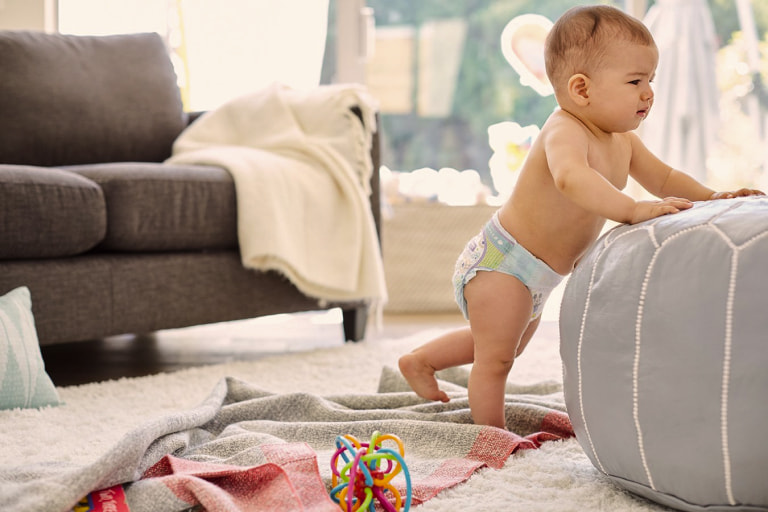Size up diapers when you notice leaks or marks on your baby’s skin. Signs of a too-tight diaper also indicate a need for a bigger size.
Choosing the right diaper size for your baby ensures comfort and prevents unwanted leaks. Diaper fit is more crucial than age or weight, though these factors often provide a helpful guideline. Every baby is unique, and differences in shape and activity level can influence when a diaper size change is necessary.
A snug, secure fit, without tightness or gap, is the goal. Parents should observe their baby for any signs of discomfort or the aforementioned issues to judge the best time to move up a size. Regular assessments of your baby’s diaper fit play a key role in avoiding discomfort and maintaining hygiene.

Credit: www.amazon.com
Spotting The Right Time To Size Up Diapers
Parents often wonder about the right time to size up their baby’s diapers. It’s critical to notice when a diaper is too snug, leading to discomfort, red marks, or diaper leaks. Babies grow at variable rates, and acknowledging unique growth patterns is essential in determining diaper fit.
Several factors play a part in deciding when to switch diaper sizes. A notable sign is the baby’s weight and measurements. Manufacturers provide weight guidelines for each diaper size, but remember, these are merely indicative. Observe how the diaper wraps around your baby’s waist and thighs. Any tightness, gap, or restriction of movement suggests it’s time to consider upsizing.
| Season | Consideration for Diaper Sizing |
| Summer | Lighter clothes might mean a smaller size can be retained longer. |
| Winter | Bulkier clothing may necessitate larger diapers for comfortable fit. |
Seasonal changes also have an impact. During summer, babies tend to wear less which can impact how a diaper fits. Conversely, winter attire is bulkier, and upsizing might be required to ensure comfort and prevent leaks. Always prioritize your baby’s comfort and the diaper’s functionality over sticking strictly to weight guidelines.
Recognize The Telltale Signs!
Frequent leaks and blowouts are a clear indicator that your baby’s diaper is too small. If you’re constantly facing this issue, it’s a sign to move up a diaper size. Red marks and discomfort on your baby’s skin often suggest the diaper is too tight and it’s time for a change.
Similarly, if the diaper feels snug and hard to fasten, your baby likely needs a larger size. Increased wet diapers unexpectedly can also imply that the current size is unable to hold the volume, urging a switch to a more appropriate diaper size for your little one.
Checking Fit And Comfort Level
To ensure a proper waist fit for your baby’s diaper, perform the two-finger test. This involves placing two fingers between the diaper and your child’s stomach. The fit should feel snug but not tight, allowing for comfort and preventing leaks. Babies grow rapidly, and maintaining the correct size ensures their utmost comfort.
Equally crucial is the assessment of leg openings. Diaper leg cuffs should hug your baby’s legs gently, ensuring no marks or signs of chafing are present. A properly sized diaper allows for a snug fit that stops leaks while preventing any redness or irritation around the legs caused by too-tight diapers.
Mobility and range of motion are indicative of a well-fitting diaper. Observe your baby’s ease of movement during play and rest. A right-sized diaper will allow your baby to move freely and comfortably without any restriction, contributing to healthy development and happy, active days.
Choosing The Next Size Up
Comparing diaper brands and their fit guides is essential to determine the right time for upsizing. Different brands may vary in their sizing, meaning a child might outgrow one brand’s size 3 before another’s. Parents should compare weight limits and fit recommendations provided by manufacturers. Additionally, consider the baby’s mobility, comfort, and any signs of outgrowing current diapers, such as marks on the skin or frequent leaks.
Identifying the optimal times to transition to a larger size typically revolves around these physical cues. Once a baby approaches the upper end of the weight range or exhibits signs of discomfort, it’s time to move up a size. It’s wise to purchase a few of the next size up in advance to be prepared for sudden growth spurts.
- Stockpile larger sizes during sales or promotions to save money and prepare for quick growth changes.
- Consider the diaper’s absorbency—will your child need more as they grow?
- Transitioning to overnight diapers may be necessary before upsizing regular diapers for better nighttime protection.
Troubleshooting Common Sizing Issues
Dealing with in-between sizes often confounds parents eager to provide their babies with optimal comfort. Choosing the right diaper size becomes more challenging as babies grow at unpredictable rates. Parents should look for specific signs indicating a size change is necessary. These signs include diapers leaving marks on the baby’s skin, frequent and unusual leakages, or when the diaper looks or feels uncomfortably tight. Monitoring these indicators closely ensures timely adjustments to the diaper size.
Adjusting for unique baby body shapes can be as personalized as each child. Every tot differs, and standard diaper sizes might not be the perfect fit for all. Babies with thicker thighs or a slimmer waist may need a different approach. Parents should experiment with various brands and styles, as they may find a particular type offers a better fit for their baby’s unique contours.
There comes a point where parents must consider specialty diapers. This is especially true for children with specific needs or skin sensitivities. Specialty diapers, designed for extra absorbency, greater comfort, or made from hypoallergenic materials, can be valuable for maintaining a happy and healthy child. Consulting pediatricians for recommendations on diaper types tailored to certain conditions or shapes can be immensely helpful.
Ensuring Seamless Transition To Larger Diapers
Ensuring a seamless transition to larger diapers requires introducing the new size progressively. Start by integrating the new size diapers into your child’s routine bit by bit. Begin this process by alternating between the current size and the next one up, allowing your little one to grow accustomed to the new fit and feeling.
Always be vigilant monitoring for any signs of irritation on your child’s skin. Signs like red marks or consistent leaks may indicate it’s time to make the switch to larger diapers. Equally important is to adjust clothing as diaper size increases since tighter clothes might cause discomfort or hinder the diaper’s functionality.
Frequently Asked Questions On When To Size Up Diapers
What Are Signs To Size Up Baby’s Diapers?
Diaper sizing typically depends on a baby’s weight and growth pattern. Signs it’s time to size up include red marks on the baby’s skin, consistent leaks, difficulty fastening the diaper snugly, or the diaper sitting too low on your baby’s belly.
How Do Diaper Sizes Vary By Brand?
Diaper sizes can differ slightly across brands due to varying fit and design. It’s essential to consult the sizing chart specific to the brand you’re using and consider your baby’s shape and comfort when selecting a diaper size.
When Should You Switch To The Next Diaper Size?
Transition to the next diaper size when your baby nears the upper weight limit of their current size, exhibits discomfort, or experiences frequent blowouts. It’s often better to size up a bit early to ensure comfort and avoid leaks.
Can A Diaper Be Too Big For A Baby?
Yes, a diaper can be too big, which may lead to leaks and poor fit. Make sure the diaper fits snugly around the waist and thighs without any gaps, while still providing comfort and allowing mobility for your baby.
Conclusion
Knowing the right time to upsize your baby’s diapers is crucial for comfort and hygiene. Keep an eye out for telltale signs like marks on the skin or frequent leaks. Trust your instincts and observe your child’s unique needs to ensure a perfect fit.
Remember, a contented baby is a happy baby!

Dr. Leah Alexander, M.D., is a board-certified Pediatrician in New Jersey and has been working at Elizabeth Pediatric Group of New Jersey since 2000. Since 2005, Dr. Alexander has worked as an independently contracted pediatrician with Medical Doctors Associates at Pediatricare Associates of New Jersey.
She also has a passion for culinary arts that extends beyond the medical realm. After completing culinary school at the French Culinary Institute, she started Global Palate, LLC, a catering firm, in 2007. She ran her own catering company for six years and served small group parties as an owner and executive chef.

